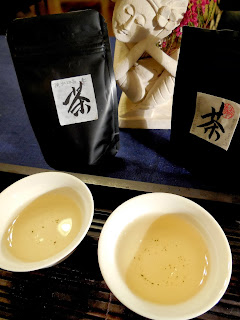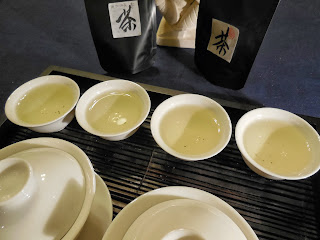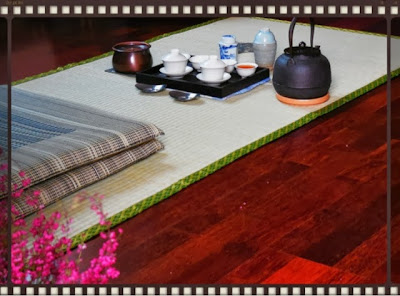No two reviews are ever identical, even when teas are brewed by the same person, in the same tea room, etc. Hence the coined Japanese term by tea master Sen Rikyu "Ichi-go, ichi-e", "一期一会“ comes to mind as every infusion differs from one occasion to another.
This spring, I started to select and make available great teas with enduring qualities on my blog, giving me one more compelling reason to take notes while taking in their indulging scents, appealing aftertastes and good energy.
Here, I start with a side by side comparison of two high mountain oolongs from the popular peaks of Da Yu Ling and Li Shan. The standards of both teas are almost neck to neck, I dare say.
Appearance wise, it may look as if the Da Yu Ling Oolong consists of fatter oolong balls, but this is the case only because the Li Shan Oolong tea that I used today came from the bottom of the package. From the photo however, it is clear that the Da Yu Ling leaves are of a darker shade of green, while the Li Shan Oolong has a yellow-green hue.
 |
| Top: DYL Spring, Bottom: Li Shan Spring |
For this test, I did not measure exact weights of my oolongs, but rather used the indentations found on my pewter saucers as a convenient guide. It also goes without saying that you should clean your utensils sufficiently because tea leaves are extremely sensitive to odours or scents in the environment or on surfaces that they come into contact with.
A few quick sniffs under both gaiwan lids gave the following. Partly fruity, partly floral concentrated and balanced scents with the Da Yu Ling. With the Li Shan Oolong, I obtained a predominantly intense floral note in comparison to the Da Yu Ling.
Having drawn preliminary conclusions from the tea scents, I decided to go for the lighter Da Yu Ling tea first. The first infusion coats the mouth with a buzzy sensation that concentrates mostly at the root of my tongue. This tea's flavour does not overwhelm you at first, but its energy very quickly extends to my stomach, producing a comforting warmth while leaving its high mountain freshness in the mouth cavity. Double enjoyment, double bliss. This makes me a very satisfied consumer.
 |
| Leaves wide open: Left, DYL, Right, Li Shan |
The colours of both infusions are very similar (only Li Shan oolong is ever so slightly yellower), except their scents gave them away. After two very satisfying sips of my Da Yu Ling, I tasted the Li Shan tea next. Powerful floral notes moved quickly from my throat to my nose as I exhaled. The complexity and stomach sensation left behind from the Da Yu Ling tea before did not feel any less after taking a sip of the Li Shan tea. This tells me how closely on par both teas are in terms of their standards.

When trying two teas in a row, it is good practice to go back to the first tea to be very sure that what you are tasting and blogging about is to the best of one's knowledge. This is why I have filled two cups of each tea, trying out one tea followed by the second tea in an alternate pattern.
As a little somehting extra up my sleeves, I only filled two cups from each tea in the first round of testing (light infusions). This means the most concentrated brew is kept at the bottom of the gaiwan as the last cup to be poured out for each tea. After my initial sips of lightly infused DYL then a Li Shan, I moved on to a stronger infusion of Li Shan to experience the same but more intense bouquet of this tea.
To follow was a DYL (strong) and the most obviously felt sensation was a two/three-fold increment in complexity throughout the mouth cavity and on the insides of my cheeks.
My verdict for this spring's Da Yu ling is subtle in terms of scent, taste and flavour yet powerful because of the way it feels in the mouth, aftertaste and overall warmth.
 |
| Order of tasting for light infusions: 1st cup - DYL, 3rd cup - LS, 2nd - DYL, 4th - LS |
Contrast this to the refine and floral Li Shan tea, such high mountain oolong experiments serve to teach us a thing or two about the most aromatic and powerful teas from Taiwan's tallest and cleanest mountain tops.
And as mentioned before, my experiences differ from yours and yours could differ from day to day. The rite of passage that marks a novice's transformation into a connoisseur is to learn from well-selected tea samples supplied by trustworthy sources.
 |
| Left: DYL, Right: Li Shan |
Editorial note: These teas were left to steep overnight and the 5th infusions remained surprisingly full-bodied and most importantly fresh. The fact that teas stay this fresh after several hours of steeping easily correlates to their quality and high mountain energy. The Da Yu Ling leaves felt supple to touch, the leaves were much fatter in thickness. Li Shan tea on the other hand had tender and rather thin leaves. I am beginning to suspect that such differences influence the way these tea infusions can feel in your mouth and suppler leaves seem to indicate higher complexity in taste.
